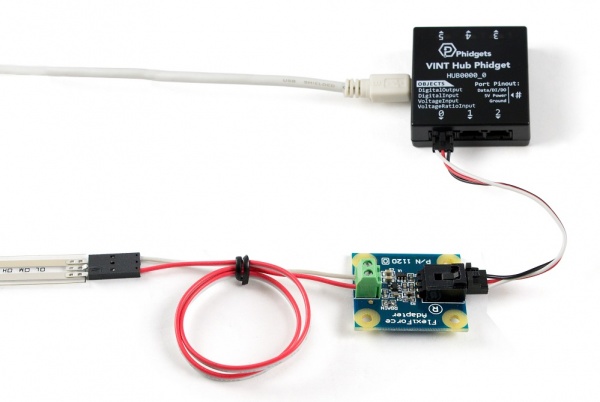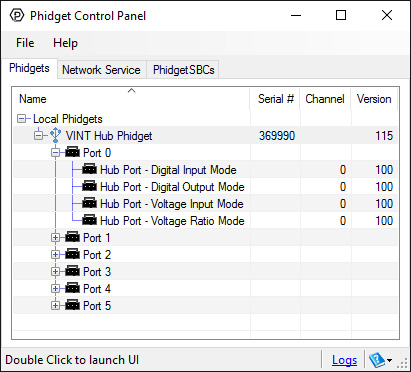
The 1120 FlexiForce Adapter makes it easy to interface a Tekscan FlexiForce force sensor to an Phidgets Voltage Input or VINT Hub Port.
This adapter can interface one Flexiforce force-sensitive resistor so that it can be read by a Phidgets Interface or Hub. Here's a list of all of the Flexiforce sensors sold here:
| Product | Sensor Properties | Physical Properties | ||
|---|---|---|---|---|
| Part Number | Price | Force Min | Force Max | Sensing Area |
 8″ FlexiForce 0-100lb. Resistive Force Sensor
|
$22.75 | 0 N | 444.8 N | 71.3 mm² |
 8″ FlexiForce 0-1lb. Resistive Force Sensor
|
$22.75 | 0 N | 4.4 N | 71.3 mm² |
 8″ FlexiForce 0-25lb. Resistive Force Sensor
|
$22.75 | 0 N | 111.1 N | 71.3 mm² |
This adapter can be read by any Phidget with an Analog Input or VINT Hub port. It will connect to either one using the included Phidget cable. VINT Hub ports can behave just like Analog Inputs, but have the added flexibility of being able to be used as digital inputs, digital outputs, or ports to communicate with VINT devices. For more information about VINT, see the VINT Overview page.
| Product | Voltage Inputs | ||
|---|---|---|---|
| Part Number | Price | Number of Voltage Inputs | Voltage Input Resolution (bits) |
 VINT Hub Phidget
|
$40.00 | 6 (Shared) | *** 15 bit |
 1-Port VINT Hub Phidget
|
$24.00 | 1 (Shared) | ** 16 bit |
 VINT Hub Phidget
|
$35.00 | 6 (Shared) | * 15 bit |
 VINT Hub Phidget
|
$30.00 | 6 (Shared) | *** 15 bit |
 Wireless VINT Hub
|
$60.00 | 6 (Shared) | * 16 bit |
 PhidgetSBC4
|
$120.00 | 6 (Shared) | * 16 bit |
 8x Voltage Input Phidget
|
$20.00 | 8 | 12 bit |
 PhidgetInterfaceKit 8/8/8
|
$80.00 | 8 | — |
 PhidgetInterfaceKit 2/2/2
|
$50.00 | 2 | 10 bit |
 PhidgetInterfaceKit 8/8/8
|
$80.00 | 8 | 10 bit |
 PhidgetInterfaceKit 8/8/8 Mini-Format
|
$70.00 | 8 | 10 bit |
 PhidgetInterfaceKit 8/8/8 w/6 Port Hub
|
$110.00 | 8 | 10 bit |
 PhidgetTextLCD 20X2 : White : Integrated PhidgetInterfaceKit 8/8/8
|
$70.00 | 8 | 10 bit |
This adapter comes with its own Phidget cable to connect it to an InterfaceKit or Hub, but if you need extras we have a full list down below. You can solder multiple cables together in order to make even longer Phidget cables, but you should be aware of the effects of having long wires in your system.
| Product | Physical Properties | |
|---|---|---|
| Part Number | Price | Cable Length |
 Phidget Cable 10cm
|
$1.50 | 100 mm |
 Phidget Cable 30cm
|
$1.75 | 300 mm |
 Phidget Cable 60cm
|
$2.00 | 600 mm |
 Phidget Cable 90cm
|
$2.00 | 900 mm |
 Phidget Cable 120cm
|
$2.25 | 1.2 m |
 Phidget Cable 150cm
|
$2.50 | 1.5 m |
 Phidget Cable 180cm
|
$2.75 | 1.8 m |
 Phidget Cable 350cm
|
$3.00 | 3.5 m |
 Phidget Cable Kit
|
$10.00 | 80 mm |
Welcome to the 1120 user guide! In order to get started, make sure you have the following hardware on hand:
Next, you will need to connect the pieces:

Now that you have everything together, let's start using the 1120!
In order to demonstrate the functionality of the 1120, we will connect it to the HUB0000, and then run an example using the Phidget Control Panel on a Windows machine.
The Phidget Control Panel is available for use on both macOS and Windows machines. If you would like to follow along, first take a look at the getting started guide for your operating system:
Linux users can follow the getting started with Linux guide and continue reading here for more information about the 1120.
After plugging in the 1120 into the HUB0000, and the HUB0000 into your computer, open the Phidget Control Panel. You will see something like this:

The Phidget Control Panel will list all connected Phidgets and associated objects, as well as the following information:
The Phidget Control Panel can also be used to test your device. Double-clicking on an object will open an example.
Double-click on a Voltage Ratio Input object in order to run the example:

General information about the selected object will be displayed at the top of the window. You can also experiment with the following functionality:
The FlexiForce Force sensor is a piezoresistor that has a very large resistance when it is not loaded (in the range of MegaOhms). The resistance decreases as more force is applied. Tekscan offers sensors with standard force ranges, such as 0-1 lbs, 0-25 lbs, and 0-100 lbs. The same adapter board can be used for all three ranges. Because the expected part-to-part variance between FlexiForce sensors is as high as 40%, it is imperative that you calibrate your sensor and determine the specific formula which applies to your sensor. For information on how to calibrate your sensor, refer to the FlexiForce User Manual from Tekscan.
The FlexiForce sensors are easy to interface to the 1120. They can be plugged into the Interface cable that is included. The other end of the cable has been stripped and tinned so that they can be easily inserted into the terminal block. This is useful if a longer cable is needed, as wires can be soldered to the stripped ends. The polarity of the FlexiForce sensors does not matter. If a larger force range is desired, a resistor on the Adapter board can be replaced. This resistor is designated as RGAIN on the board and has a default value of 15kΩ. When the RGAIN resistor value is reduced, the sensor becomes less sensitive and more force can be applied before saturating the output. Conversely, if the RGAIN value is increased, the sensitivity increases and the output saturates at a lower applied force. If RGAIN is changed, calibration with known forces will have to be done to determine the proper formula. Based on limited testing, RGAIN=5kΩ will give enough range to measure up to 1000 lbs with the 100 lbs Flexiforce sensor. Changing the gain by much larger amounts can cause sensor instability and is not recommended. Also note that adjusting the gain is not a substitute for calibrating and conditioning the sensor. You should look at the manual for the sensor you are using and follow all calibration procedures contained therein before resorting to adjusting the gain value to achieve accurate results.
To obtain the most accurate results, it is recommended that the sensor rests on a smooth surface and the object is only on the sensing pad and centered as much as possible. This can be achieved by using a small disc (included) that is just large enough to cover the sensing pad, and then placing the full force on the disc. Without the disc, the object may rest on the surrounding surface and record the force inaccurately. Care must also be taken to avoid jagged or sharp edges on the sensing pad, as it can affect the measurement as well as potentially puncture the pad. The pad at the end of the strip is the only place where force is sensed. Any force along the rest of the strip is ignored. The longer the object rests on the sensing pad, the more the sensor voltage will drift and vary slowly in value. It is very difficult to compensate for the drift since different constant forces will produce different drift rates. For this reason, the average accuracy of this sensor is approximately 5%.

The Phidget Cable is a 3-pin, 0.100 inch pitch locking connector. Pictured here is a plug with the connections labelled. The connectors are commonly available - refer to the Analog Input Primer for manufacturer part numbers.
| Sensor Properties | |
|---|---|
| Controlled By | VoltageRatio Input |
| Sensor Output Type | Ratiometric |
| Electrical Properties | |
| Supply Voltage Min | 4.5 V DC |
| Supply Voltage Max | 5.3 V DC |
| Current Consumption Min | 2.6 mA |
| Current Consumption Max | 3.2 mA |
| Current Consumption (Overload) | 10.9 mA |
| Measurement Error Max | ± 5 % |
| Physical Properties | |
| Recommended Wire Size | 16 - 26 AWG |
| Operating Temperature Min | -40 °C |
| Operating Temperature Max | 105 °C |
| Customs Information | |
| Canadian HS Export Code | 8473.30.00 |
| American HTS Import Code | 8473.30.51.00 |
| Country of Origin | CN (China) |
| Date | Board Revision | Device Version | Comment |
|---|---|---|---|
| February 2010 | 0 | N/A | Product Release |
This device doesn't have an API of its own. It is controlled by opening a VoltageRatioInput channel on the Phidget that it's connected to. For a list of compatible Phidgets with VoltageRatio Inputs, see the Connection & Compatibility tab.
You can find details for the VoltageRatioInput API on the API tab for the Phidget that this adapter connects to.